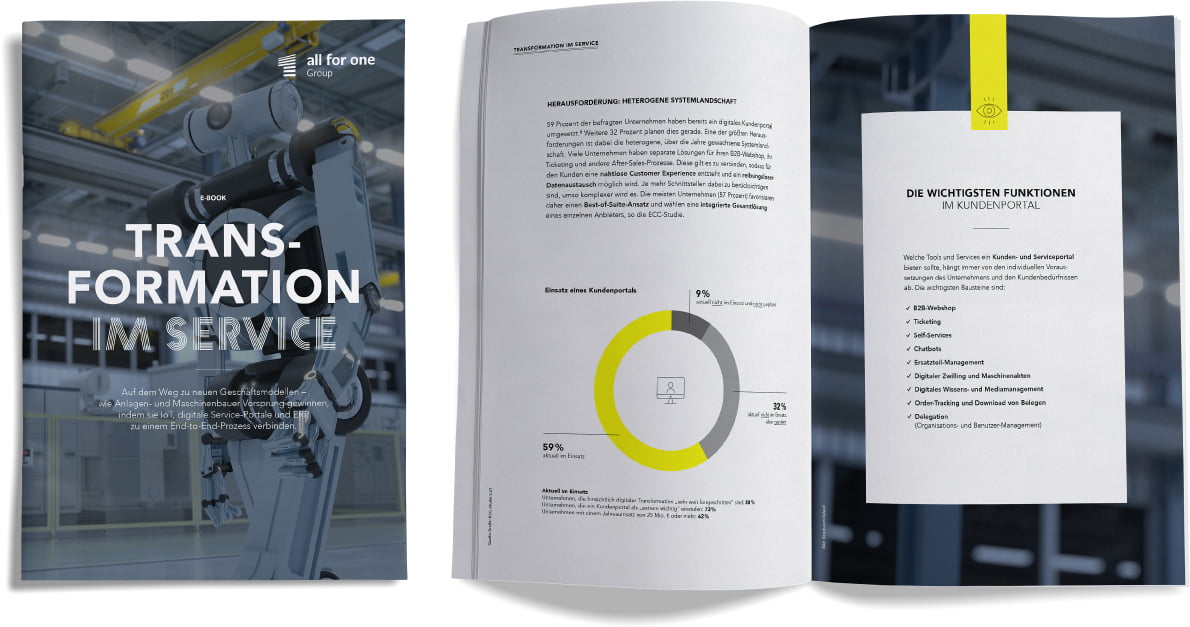Industrial Transformation


In the future, manufacturing companies will no longer be able to remain competitive by selling products alone. This is the prediction of the VDMA study "Future Services 2035", which developed various visions of the future based on expert workshops.
In a back-to-basics scenario, where everything remains as it is, machine manufacturers would be alienated from their customers, decoupled from the value chain, and lose their position as innovators. Growing challenges mean there is no alternative to transformation in the manufacturing industry.
For years, companies have been struggling with fierce global competition. They must compete with manufacturers in low-wage countries that offer their products at significantly lower prices. As a result, the traditional sales business of many German machine builders is stagnating. The situation is exacerbated by disrupted supply chains and an ongoing shortage of skilled labor. On top of this, there are stringent environmental regulations, rising CO2 prices, and increasing regulatory requirements.
Service-based business models
Becoming a service provider can solve or at least mitigate many of these challenges. Equipment manufacturers are already shifting more of their business to after-sales, where they can generate good margins on spare parts and technical services. The goal now is to get even closer to customers and create a win-win situation. Companies can achieve this by moving from selling individual products and services to offering comprehensive solutions in a subscription model.
The goal is Equipment as a Service (EaaS). Customers do not buy a machine, but receive it as a service and pay for its use or performance. In this way, both parties become partners, working together for the success of the business. In this model, customers benefit from the guaranteed availability of the machines—an attractive added value for which they are willing to pay a little more.
In addition, they do not have to make large initial investments and turn capex into opex. Suppliers, on the other hand, generate a continuous cash flow, can tie customers more closely to the company, and can develop their services in a customized way. Because this type of business model aims to extend the lifecycle of a machine, companies also improve their sustainability footprint. They conserve resources and reduce their CO2 emissions.
Service-based business models require end-to-end digital processes. To keep production equipment running, manufacturers need to collect and analyze data from the customer environment. This enables them to optimize maintenance through predictive maintenance and remote support. At the same time, the data provides insight into when which customer is likely to need which spare part.
Manufacturers can adjust inventory levels and order resources in a timely manner, making them less vulnerable to supply chain disruptions. For service-based business models to succeed, companies must also design their customer-facing processes for maximum efficiency. Self-service and automation play a key role. Not only do they free up employees and help address skills shortages, they also improve the customer experience.
Getting started with value
For most companies, EaaS is still more of a vision. However, it is not absolutely necessary to reach the final stage of expansion. There are many areas where value can be added along the way. The key is to establish the first digital end-to-end processes— ideally where the greatest benefit can be achieved with the least effort. To do this, companies should define a business case and start with a small prototype.
A simple practical example is automated material ordering: a data analytics model can be used to predict how much lubricant a machine will use and when it needs to be replenished. The information is then sent to the manufacturer's SAP system, where it automatically triggers the ordering process. The customer receives a notification, and the service technician can replenish the lubricant without unplanned downtime.
IoT creates the data foundation
What are the technical requirements for building an end-to-end digital process? One of the key building blocks is IoT. This technology closes the gap that previously existed between the manufacturer's SAP ERP system and the machines used by the customer. Data from sensors or machine controls is then transferred via a connectivity solution to a central data service, where it is stored and analyzed. It can then be further processed and linked to ERP processes. This can be implemented well, for example, with the interaction of S/4 and microservices from hyperscalers. Both AWS and Microsoft Azure offer suitable solutions on their platforms.
Portal as a central touchpoint
The second important building block for a digital end-to-end process is an intelligent customer and service portal. It consolidates all communications and interactions between customers and the company into a single touchpoint. Data from both the customer and supplier sides flows into this portal, making the platform the link between production, ERP, and CRM.
For example, customers can use the service portal to order spare parts, initiate maintenance orders, submit support requests, open tickets, or access tutorials and documentation on their machines. For optimal support, a chatbot is available 24/7 to quickly provide information and answer common questions. Condition monitoring data from the production environment can also be visualized in the customer portal—for example, with a digital twin that provides an accurate virtual representation of the customer's specific machine.
SAP Commerce Cloud
Vollmer-Werke, based in Biberach, Germany, has already implemented an intelligent customer portal with a digital twin based on SAP Commerce Cloud. The solution includes an IoT machine gateway, a cloud platform, and SAP integration. The sharpening machine manufacturer's globally distributed customers can now log into their personal area of the service portal and view the status of their machines. They also have access to a wealth of information, chatbots, and other services, including live calls with experts.
Best-of-Suite with SAP
To achieve service transformation, companies need a system landscape that is digitized, automated, efficient, and transparent. The SAP ecosystem, including S/4 Hana, SAP Sales and Service Cloud, and SAP Commerce Cloud, provides the foundation for this. Because many different systems need to communicate with each other in an end-to-end digital process, a best-of-suite approach is advantageous.
A unified system landscape reduces complexity, facilitates automation, and enables smooth interaction between the components involved. It also simplifies maintenance because the appropriate interfaces are automatically updated when the SAP system is updated.
More than just technology
Although it may seem obvious to focus on the technical aspects of service transformation first, companies should think about cultural and organizational change from the outset. Almost every department is affected - especially sales. In future, employees will no longer just have to sell products, but also deal intensively with customer processes. Change management measures are important to promote a service-oriented mindset.
Ultimately, it is the triad of people, technology and process integration that will lead the transformation in service to success. Companies should consider all three pillars from the outset. The best time to start is now. With IoT, a digital customer portal and SAP integration, companies can set up their first end-to-end processes and quickly achieve tangible added value.
On the way to new business models
Get the e-book "Transformation in Service: on the Way to New Business Models". The free guide explains the background and shows possible solutions. Read how you can create the data basis with IoT, design a holistic customer experience with a smart customer and service portal, and establish digital end-to-end processes in service step by step.







